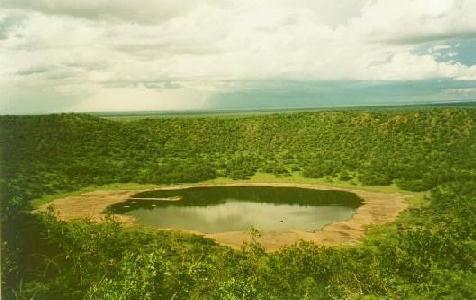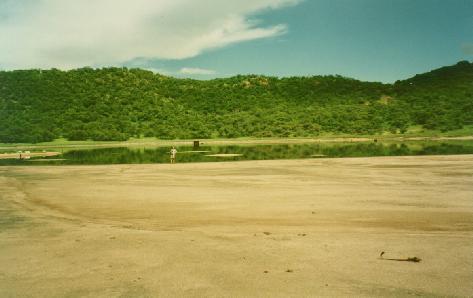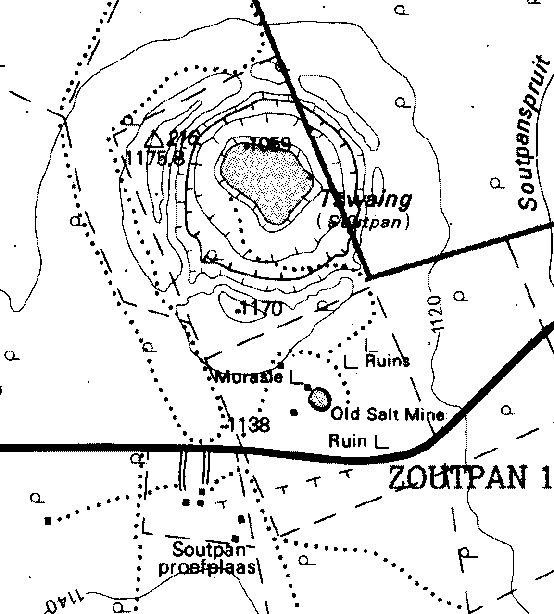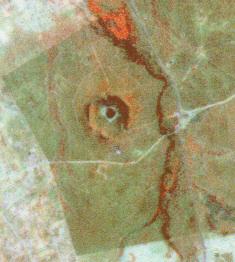
HartRAO Home > Things to do > Visit the Tswaing/Soutpan meteor crater
The photographs below show you what it looks like today.
The crater is called Tswaing in seTswana, the local language of the area, or Soutpan in Afrikaans. Both names mean Salt Pan and this derives from the lake of salty water that fills the centre.
There is a museum adjacent to the crater. A path leads from the museum to the crater, along the rim, and down to the central lake. The crater is covered with indigenous trees and bushes, and attracts a variety of bird life.

|
|---|

|
|---|

|
|---|

|
|---|
Courtesy of Google, there is also now a satellite image in which you can zoom in or out.
Tswaing is reached by taking the M35 (Soutpan) road from Pretoria going north past Ondersterpoort.
Here are the first map and second map of the route from Pretoria, not to scale. This map of the area is to scale.
For GPS users, the coordinates of the new entrance to Tswaing are Latitude 25.409 S and Longitude 28.0958 E.
For more information on visiting the Tswaing crater site and museum, which is run by Ditsong Museums of South Africa, see the official Tswaing Meteorite Crater home page.
The kinetic energy released when an object travelling at this speed is brought to rest in the impact is 100 million Joules per kilogram of mass. This is 25 times greater than the energy produced by the detonation of the same mass of high explosive such as TNT.
It has been calculated that the energy required to produce the Barringer crater was equivalent to the explosion of 15 million tonnes of TNT. As the Tswaing crater is slightly smaller than the Barringer crater, we shall assume that the energy of the explosion there was equivalent to 10 million tonnes of TNT. This happens to match the energy calculated to have been released in the Tunguska airburst event in Siberia in 1908.
The Tswaing impact energy release also matches the power of the first US hydrogen (fusion) bomb, codenamed "Mike", exploded at Eniwetok on 31 October 1952. It is one third the power of the largest Soviet test bomb, which had a yield of 58 Megatons, and was dropped on Novaya Zemla on 31 October 1961. However, 10 Megatons is 500 times the power of the 20 kiloton atomic (fission) bomb that devastated Hiroshima on 6 August 1945, killing about 150 000 people.
We noted above that 1 kilogram of TNT releases 108/25 = 4 x 106 Joules of energy.
Then 107 tons of TNT = 1010 kilograms of TNT will release 4 x 1016 Joules of energy.
This energy comes from the kinetic energy of motion of the asteroid being released as it is brought to rest on impact. We can then use the well known equation:
Kinetic Energy = 1/2 * Mass * Velocity2.
Rewriting this to solve for the mass gives:
Mass = 2 x 4 x 1016 / 160002 = 3 x 108 kilograms, ie 300 000 tonnes.
If the object was roughly spherical, then its mass would be given by
Mass = 4/3 * Pi * Density * Radius3
This allows us to calculate its size. The object was probably made of rock with a density of about 3 tonnes per cubic meter. This is a typical density - for comparison, water has a density of 1 tonne per cubic metre. Rewriting the equation above to solve for the radius, we can then calculate that the object would have had a diameter of about 60 metres. This sort of object would have been a small asteroid. An asteroid whose orbit intersects that of the Earth - as this one's did - is called a meteoroid. The smallest objects detected telescopically near the Earth are about the size of this one.
You can read all about it in the popular book entitled "Tswaing Meteorite Crater - Popular Geosciences Series 1" ISBN 1-875061-68-1 published in 1999 by the Council for Geoscience of South Africa. The authors are W U Reimold, D Brandt and J Hancox of the University of the Witwatersrand with R de Jong of the National Cultural History Museum. The book is a well illustrated softcover, 170 pages. It is written in an informative and accessible way, and is to be recommended. It is available from the Council for Geoscience and some bookshops in South Africa.
The 'Earth Impact Effects Program' by Robert Marcus, H. Jay Melosh, and Gareth Collins, is an easy-to-use, interactive web site for estimating the regional environmental consequences of an asteroid impact on Earth. This program will estimate the ejecta distribution, ground shaking, atmospheric blast wave, and thermal effects of an impact as well as the size of the crater produced, after you set up the asteroid parameters.